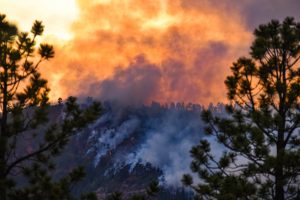Following up on new excessive heat regulations, Oregon has issued temporary rules to protect employees from wildfire smoke. The rules have training and notification requirements and, notably, respirator specifications.
Who’s Covered, Not Covered
The new temporary rules apply whenever employees will be exposed to wildfire smoke producing an ambient air concentration for fine particulate matter with a diameter less than 2.5 micrometers in size, often referred to as PM 2.5, resulting in an Air Quality Index (AQI) of 101 or above. Forest fire smoke often hits those numbers.
The rules specifically exempt workers in enclosed buildings and structures with mechanically filtered air as long as the employer ensures all windows and exterior openings are closed except when necessary to enter and exit.
Similarly, the rules don’t apply when (1) employees are in vehicles with a cabin air filter and (2) windows and doors are kept closed except as necessary. Mass transportation, such as buses and light rails where doors are frequently opened to board and disembark passengers, however, aren’t exempt from the rules.
Wildland firefighters, rescue, utilities, communications, and medical operations involved in aiding emergency or firefighter operations are exempt from the training requirements but aren’t exempt from the notification and exposure-control rules described below.
What’s Covered
Training. Beginning August 16, 2021, unless covered employers plan to suspend operations whenever the AQI is 101 or above, they must provide training. The topics include explaining the symptoms and health effects of wildfire smoke exposure, identifying those who might be particularly sensitive, and underscoring an employee’s right to report exposure without retaliation. The training also must cover:
- Procedures for supervisors to follow when an employee exhibits symptoms of wildfire smoke exposure;
- How employees can get information on ambient air concentrations or AQI levels
- How to operate and interpret the employer’s air quality monitoring devices
- Methods to be used to protect employees from wildfire smoke
- Importance, methods, limitations, and benefits of using a filtering facepiece respirator.
Training materials were supposed to be available from the Oregon Occupational Safety and Health Administration (OSHA) by August 6.
Communication. Employers must develop and implement a system to communicate wildfire smoke hazards to employees. Workers must be notified when poor air quality reaches three different levels: AQI 101, 201, and 501.
Employees also must also be told when AQI levels drop below the marks requiring protective measures and encouraged to inform the organization when air quality improves or worsens.
Exposure control. Oregon’s temporary rules mandate the provision and, in some circumstances, use of respirators. Whenever the AQI is 101 or above, the employer must be able to provide a sufficient number and sizes of respirators approved by the National Institute for Occupational Safety and Health (NIOSH) to employees wherever they’re located and exposed. The respirators must be readily available for voluntary use and provided at no cost.
For the 2021 wildfire season, employers may substitute KN95 masks for NIOSH-approved filtering facepiece respirators unless the AQI exceeds 501.
Employers also must use any engineering or administrative controls to reduce the exposure below AQI 201 whenever possible. For examples, they could (1) provide enclosed buildings or vehicles with filtered air, (2) relocate work to another location where the air concentration is less than AQI 201, or (3) change work schedules to seek better air quality.
When employees’ exposure is at AQI 201or above even after the application of engineering or administrative controls, the employer must ensure employees wear NIOSH-approved respirators. When the respirators are used exclusively to protect employees from wildfire smoke, the employer doesn’t need to implement a full respiratory protection program and may use the wildfire smoke respiratory protection program described in the appendix to the rules.
When the AQI is 501 and NIOSH-approved respirators are necessary, the employer must provide a complete respiratory protection program as described in the Oregon OSHA rules.
Bottom Line
First, you must be ready to begin training on August 16, 2021.
Second, before employees are exposed to AQI 101 or above, you must have in plan in place to gain access to air quality information and communicate it to workers.
Lastly, you will need to have (1) KN95 masks (at a minimum) available for all employees subject to wildfire smoke and (2) NIOSH-approved respirators when there’s the potential for significant poor air quality.
Calvin Keith is a partner with the law firm of Perkins Coie LLP in Portland, Oregon. You can reach him at ckeith@perkinscoie.com.

